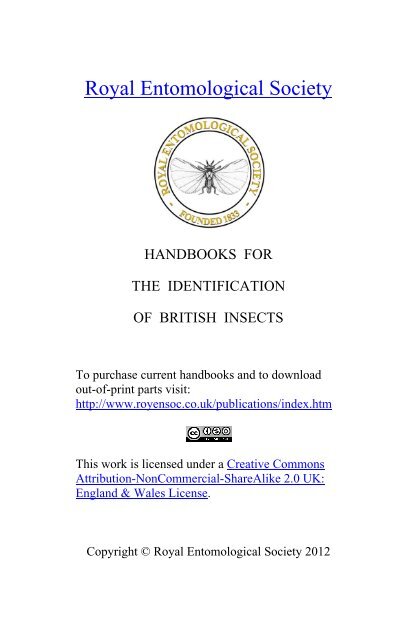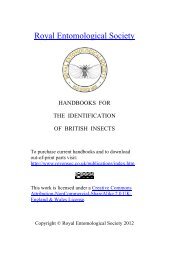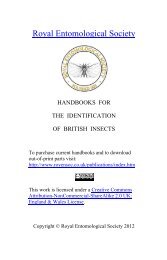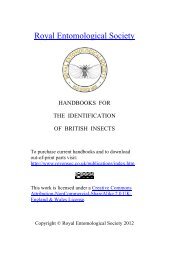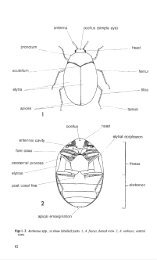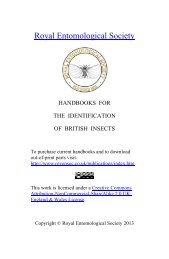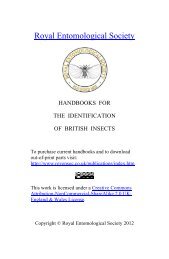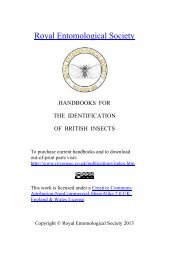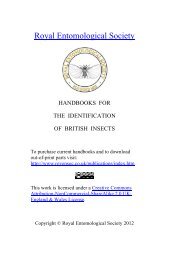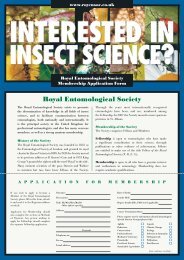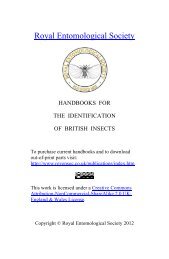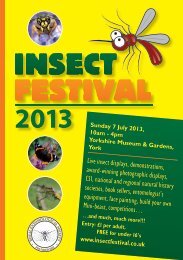Vol 5 Part 12. Coleoptera. Cerambycidae. - Royal Entomological ...
Vol 5 Part 12. Coleoptera. Cerambycidae. - Royal Entomological ...
Vol 5 Part 12. Coleoptera. Cerambycidae. - Royal Entomological ...
- No tags were found...
Create successful ePaper yourself
Turn your PDF publications into a flip-book with our unique Google optimized e-Paper software.
ROYAL ENTOMOLOGICALSOCIETY OF LONDON <strong>Vol</strong>. V. <strong>Part</strong> I 2.HANDBOOKS FORTHE IDENTIFICATIONOF BRITISH INSECTSCOLEOPTERACERAMBYCIDAEByE. A. J. DUFFYLONDONPublished by the Societyand Sold at its Rooms;.p, Queen's Gate, S.W. 7~th September, I 9 pPrice Three Shillings and Sixpence
ACCESSION NUMBER ......... S.. .. 1 .. ?::-.. ..British <strong>Entomological</strong> & Natural HistorySocietyc/o Dinton Pastures Country Park,Davis Street, Hurst,Reading, BerkshireRG10 OTHPresented byDate····· ···· ···· ·········· ············· ·········· ······ ········· ···· ········ ·· ····· ····LibrarianREGULATIONSI.-No member shall be allowed to borrow more than five volumesat a time, or to keep any of them longer than three months.2.-A member shall at any time on demand by the Librarianforthwith return any volumes in his possession.3.-Members damaging, losing, or destroying any book belonging{o the Society shall either provide a new copy or pay suchsum as the Council shall think fit.1 NO_OF_COPIES2SOUTH LONDON<strong>Entomological</strong> and Natural History SocietyAt the Rooms ofThe Junior Institution of EngineersPepys House, 14 Rochester Row, London, S.W.I~~~~Date\Ct~)......... ~.6~ .. ·~ - ......... ~ ... ...Z.. . !.~ --~ rbrarianREGULATIONSI.-Books may be borrowed at all Meetings of the Society.2.-No Member shall be allowed to borrow more than threevolumes at a time, or to keep them longer than one month.3.-Any Member retaining a volume or volumes beyond thespecified time shall pay a fine of Twopence per fortnight foreach volume so retained.4.-Members damaging. losing, or destroying any book belongingto the Society shall either provide a new copy or pay suchsum as the Council shall think fit.
COLEOPTERA(CERAMBYCIDAE)KEYS TO GENERA AND SPECIES.By E. A. J. DUFFYINTRODUCTION.THE family <strong>Cerambycidae</strong>, members of which are popularly known as"Longhorns," is of world-wide dist.ribution and comprises well over 20,000described species, of which just over 60 are listed as British. Owing totheir comparatively large size, elegance, variety of colour and form andmimetic and protective resemblance to various other insects, this familyof beetles is perhaps the best known and most popular amongst collectorsand taxonomists alike.ADULT CHARACTERISTICS.The following are the main characteristics of this family : Form generallyrather elongate, usually more or less depressed, with the elytra broaderthan the thorax, often considerably so. Eyes large, their extension aroundthe bases of the antennae frequently pronounced; the emargination of theinner edge is sometimes so deep that the eyes are divided or almost dividedinto two portions. The characteristic antennae, from which these beetleshave gained their popular name, arise from conspicuous tubercles on thefront of the head ; generally they are filiform, although occasionally theymay be serrate or pectinate, or may bear tufts of ornamental hairs; usuallythey are at least as long as the body, sometimes considerably longer, buton the other hand there are many species in which the antennae scarcelyreach the shoulders of the elytra. The tarsi are actually five-segmented,although with few exceptions the fourth segment is considerably reducedso that they appear to be only four-segmented ; the third segment is alwaysstrongly bilobed. Many species superficially resemble the CHRYSOMELIDAEfrom which they may usually be distinguished by their more elongate forp1,proporionately longer legs and their pubescent elytra ; moreover there isa tendency for the epimera of the metathorax to extend to the sides of theventral segments, whereas in the latter family the first ventral segment isprolonged forwards at the sides to meet the metathorax.ECONO~HC IMPORTANCE.Most Cerambycids live in the wood of various trees, some confiningthemselves to one host-plant, while others are not selective. Decaying,injured, or recently felled timber is generally the most vulnerable to attack.Much damage is caused annually by these insects abroad. In thiscountry damage is comparatively negligible and is usually confined toI
2 V (12). COLEOPTERA: CERAMBYCIDAEplantations and scattered trees of ornamental value ; Hylotrupes bajulus(Linnaeus) (the "House Longhorn ") may prove to be a notable exception;in many countries this species has caused severe and widespread damage,especially to structural timbers of houses. In this country, however,infestation so far appears to be confined to a few areas. Some species suchas those of Rhagium and Arhopalus, however, are beneficial to forestry, asthey speedily break down old stumps and logs.ADULT HABITS.Many species of Cerambycids appear to require a certain amount ofnourishment in the adult stage. Most LEPTURINAE, for example, assemble onflower-heads to feed on pollen, whereas many Lamiids feed on leaves andstems.Copulation usually occurs a day or so after the emergence of the adultsfrom their pupal cells ; this usually takes place on the branches or boles ofthe host trees, although in the case of the LEPTURINAE it frequently takesplace on flower heads, often some distance away from the host trees.Oviposition is performed on bark, in cracks of bark or wood, in oldemergence holes, in stems of plants, or even in the soil. Certain speciesexcavate special egg cavities with their mandibles or bore holes with theirovipositor to accommodate the eggs.When molested, many species stridulate audibly. This is accomplishedusually by the striate area of the produced mesonotum being scraped by aseries of sharp ridges on the posterior margin of the pronotum as the latteris raised or lowered.A few species, particularly those ofthe Callichromini, possess the facultyof scent emission. The scent emitted is usually pleasant, as in Aromiamoschata (Linnaeus) (the British " Musk beetle"), although in the case ofAgapanthia villosovi·ridescens Degeer it is less agreeable, resembling thesmell of snuffed candles. The scent glands are situated in the metathorax,the apertures being visible on the metasternum.EGGS.Cerambycid eggs are usually slender, cylindrical, fusiform or elongateovoid, with rounded ends. The chorion may be smooth or rugose (oftenmicro-reticulate), the usual colour being white or pale yellow. The incubationperiod for most species is approximately 14 days.LARVAE.Cerambycid larvae are soft whitish grubs with powerful mandibles andare generally recognizable by their subcylindrical, elongate tapering form.The thoracic legs, when present, are short or vestigial, the ventral mouthpartsare protracted and the mandibles are gouge-shaped or wedge-shaped.Some of the abdominal segments bear dorsal and ventral ampullae (i.e.,tuberculate protuberances to assist in locomotion). Spiracles are of theannular bilabiate type. The terminal urogomphi, when present, are neversegmented.The first-instar larvae generally differ from those of later instars in thatthey possess biforous spiracles and abdominal egg-bursting spines (Duffy,1949).
4 V (12). COLEOPTERA: CERAMBYCIDAEwith an asterisk, *, ~nd doubtfully indigenous species have been indicatedby an asterisk enclosed in brackets (*). All figures have been prepared bythe writer.REFERENCES.BLAIR, K. G., 1941, Rhagium bijasciatum Fab., and its Varieties in Britain. Proc. S.Land. ent. nat. Hist. Soc. 1940- 41 : 39-42, 1 pi.CRAIGHEAD, F . C., 1923, North American Cerambycid Larvae. Bull. Dept. Agric. Can.(N.s.) 27 : 1-239, 44 pls., 8 figs.DuFFY, E. A . J., 1946, A contribution towards the biology of Prionus coriarius L.(<strong>Coleoptera</strong>, <strong>Cerambycidae</strong>). Trans. R. ent. Soc. Land. 97: 419- 442, 2 pis., 17 figs.--, 1949, A contribution towards the biology of Aromia moschata. L ., the " Musk"beetle. Proc. S. Land. ent. nat. Hist. Soc. 1947- 48: 82-110, 2 pis., 16 figs.--,(in the press), A Monograph of the Immature Stages of British and I mported TimberBeetles (<strong>Cerambycidae</strong>).FowLER, W. \V., 1889, The Coleoptem of the British Islands. 4. London.JoY, N . H., 1932, A Practical Handbook of British B eetles. 2 vols. London.KAUFMANN, R. R. U., 1944, Notes on Rhagium bifasciatum F. (Col., <strong>Cerambycidae</strong>) andits varieties. Ent. mon. Mag. 80 : 262-263.--, 1945, Further notes on the colour forms of Rhagium bifasciatum F. (Col., <strong>Cerambycidae</strong>).Ibid. 81: 186- 187, 5 figs.--, 1946, Preliminary notes on Strangalia maculata Poda (Col., <strong>Cerambycidae</strong>) andits aberrrations in Great Britain. Ibid. 82: 115- 117, 16 figs.--, 1946, The distribution of Rhagium bifasciatum F . and its aberrations in theBritish Isles. Natumlist, Land. 1946: 139-146, 1 map.--, 1947, Notes on Grammoptera holomelina Poole, and the other forms of G. ruficornisF. (Col., <strong>Cerambycidae</strong>). Ent. mon. Mag. 83: 10- 12, 3 figs.PERRIER, R., 1937, La Faune dda France. Coliopteres. 6 (2). Paris.REITTER, E., 19<strong>12.</strong> Fauna Germanica. Die Kafer des Deutschen Reiches. 4. Stuttgart.VAN EMDEN, F. I., 1939-40, Larvae of British Beetles. I. Key to the genera and mostof the species of British Cerambycid lar.vae. Ent. mon. Mag. 75: 257-273 ; 76:7-13, 6 figs.KEY TO SuBFAMILIES OF CERAMBYCID ADULTS.1 Sides of thorax distinctly m argined, armed with three or more teeth (figs. 2 and 3).Front coxae transverse (fig. 4a). Prosternum appreciably produced in the formof a blunt process behind anterior coxae (fig. 4a). Length at least 23 mm.l. PRIONINAE (p. 5).Sides of thorax not margined ; lateral t eeth usually absent but sometimes onepair present only (fig. 1). Front coxae round (fig. 4b), oval, or conical (fig. 11).Prosternum not or scarcely produced behind anterior coxae (fig. 4b) 000000 000000 00.2.2 Front of head vertically inclined to longitudinal axis of body or strongly inflexed.Anterior tibiae obliquely grooved on their inner side (fig. 25). Apical segmentsoflabial pal pi tapering or pointed 0000 000000 000000 000000 000000 oooooo5. LAMIINAE (p. 13).Front of head obliquely or subvertically inclined to longitudinal axis of body.Anterior tibiae not grooved on their inner side. Apical segments of labial pal pienlarged oo• oo• •oo oo• oo• oo• oo• oo• oo• oo• oo• oo• •oo oo• oo• oo• oo• oo• oo• oo, oo, •oo oo• oo• 000 000 oo• 000 •• •••• 3.3 Anterior coxae distinctly conical (fig. 11). Sides of head strongly constrictedbehind temples, which are usually strongly protuberant. Elytra usually stronglytapering posteriorly (fig. 1) 000000 000000 oooooo 000000 000000 000000 00.2. LEPTURINAE (p. 5).Anterior coxae round or oval but never conical. Sides of head never stronglyconstricted behind temples, which are scarcely protuberant 00 00 00 00 00 00 00 00 00 00 00 • .4.4 Femora distinctly clavate (fig. 18) or petiolate (fig. 14) apically, or thorax withlateral tubercles, or elytra mucronate apically. Hind femora usually extendingbeyond apices of elytra oooo oo 000000 0000 00 0000 00 000000 oo .. oo oo .4. CERAMBYCINAE (p. 9).F emora not or scarcely clavate apically. Thorax without lateral tubercles. Elytranever mucronate apically. Hind femora not extending beyond apices of elytra.Front coxae subcontiguous. Body entirely brown or black. From Coniferaeonly 000000 oo• oo• oo• 000000000000 .... 00 000000 000000 oooooo 000000 oo• oo • oo• oo• oo.3. AsEMINAE (p. 8).
PRIONINAEKEYS TO GENERA OF BRITISH AND IMPORTED CERAMBYCID ADULTS.1. PRIONINAE.1 Thorax with three pairs of lateral spines, the middle pair the longest (fig. 2) . Thirdsegment of antenna less than twice as long as first. Apices of elytra. scarcelyor slightly dentate at sutural angle. Length 23-40 mm. From both coniferousand deciduous trees ............... ...... .................. Prionus coriarius (Linnaeus).Thorax with numerous spines distributed along entire lateral margin (fig. 3) .Third segment of antenna more than twice as long as first. Apices of elytradistinctly mucronate at sutural angle. From coniferous trees only ......* Ergates.* Ergates.Lateral spines on thorax shortest at middle, becoming longer towards the front andhind margins (fig. 3a). Length 28-60 mm. North American species* E. spiculatus Leconte.Lateral spines on thorax longest at middle and with one pair of much longerspines just behind middle (fig. 3b). Length 25-45 mm. European species* E. faber (Linnaeus).FIG. 1.-S tenocorus meridianus (L.), female.2. LEPTURINAE.Chiefly from rotten wood and on flowers of Umbelliferae, etc.l Thorax with a conspicuous pair of lateral, rather blunt, pubescent tubercles(fig. l) ........................ ... ...... ...... .. ............. ... .................. ... ...... ...... ... 2.Thorax without lateral tubercles ... ............ ... ...... .. .... .. ............................... 3.2 Antennae short, not extending as far as middle of elytra ; third segment shorterthari first . Presternal process reaching posterior part of anterior coxae.Posterior tarsi with first segment depressed, strongly broadened apically, notlonger than second and t hird together (fig. 5b) ...... ... . ... ......... Rhagium (p. 6) .
6 V (12). COLEOPTERA: CERAMBYCIDAEAntennae longer, extending beyond middle of elytra; third segment much longerthan first (fig. 1). Prosternal process not nearly reaching posterior part ofanterior coxae. Posterior tarsi with first segment subcylindrical, scarcelybroadened apically, much longer than second and third together (fig. 5a).Length 15-24 mm. Elytra black or brown ...... Stenocorus meridian us Linnaeus.3 Posterior angles of thorax more or less right-angled or evenly rounded (fig. 6) ......4.Posterior angles of thorax acutely produced into a distinct spine·like process(fig. 7) ................................................................................. ............ 5.4 Elytra parallel-sided and broadly rounded apically. Thorax red. Elytra bluishblack.Length 7-9 mm ............................... Acmaeops collaris (Linnaeus).Elytra slightly to strongly tapering posteriorly. Thorax usually black, but if redthen elytra also red ............................................................ Leptura (p. 6).5 Elytra broadly rounded apically (fig. 8) ...................................................... 6.Elytra obliquely truncate and marginate or mucronate apically (fig. 9). Elytraalways strongly tapering posteriorly ................................. Strangalia (p. 7).6 Elytra distinctly tapering posteriorly ; yellow with black markings (fig. 8)Judolia (p. 8).Elytra parallel.sided; yellow or black, never both ....................................... 7.7 Antenna with first segment shorter than third segment. Eyes almost touchingfront margin of head. Elytra black ................................. Grammoptera (p. 8).Antenna with first segment as long as third. Eyes placed well behind front marginof head. Elytra yellowish-brown. Length 6-8 mm.Alosterna tabacicola (Degeer).Rhagium.1 Antennae long, extending well beyond shoulders of elytra ; very finely pubescent.Elytral pattern variable but usually consisting mainly of a pair of oblique yellowbands; shoulders reddish-brown. Length 14-18 mm.R. bifasciatum Fabricius. *Antennae shorter, not or only just reaching shoulders of elytra; with dense greyishpubescence. Elytral pattern n ever with oblique yellow bands ; shouldersblack .................................................................................... ............ 2.2 Temples p arallel-sided behind eyes (fig. 10). H ead with a deep longitudinalmedian impression between eyes (fig. 10). Head and thorax covered with goldenpubescence. Length 14--19 mm ..................................... R. mordax (Degeer).Temples distinctly converging behind eyes. Head without an impression betweeneyes. Head and thorax covered with greyish-white pubescence. Length 12-15mm. Northern species .......................................... R. inquisitor (Linnaeus).Leptura.1 Elytra shining, entirely testaceous; apices broadly rounded. Length 6-9 mm.L. livida Fabricius.Elytra dull, entirely black, red or yellow, or black and yellow; apices obliquelytruncate or emarginate ........................................................................ 2.2 Elytra subparallel-sided ; black, each with three orange or yellow marks whichare sometimes confluent. Length 8-ll mm. Southern speciesL. sexguttata Fabricius.Elytra distinctly tapering posteriorly; never black with orange or yellow marks ... 3.3 Elytra entirely black. Scutellum covered with very dense golden pubescence.L ength 14-18 mm. Chiefly from Fagus. .................. L. scutellata Fabricius.Elytra mainly or entirely red or yellow. Scutellum sparsely covered with finegreyish pubescence ..................................................................... .........4.4 Elytra yellow with apices broadly black. L ength 10-14 mm .... L. fulva Degeer.Elytra entirely yellow or red ..................................................................... 5.5 Pubescence on elytra black. Legs entirely black ; first segment of hind tarsusmore than four times as long as second. Length 9-12 mm.L. sanguinolenta Linnaeus.Pubescence on elytra pale yellow. Legs with tibiae and tarsi yellow ; first segment of hind tarsus less than four times as long as second. Length 12-20 mm.L. rubra (Linnaeus).* For key to varieties, see Blair (1941), and Kaufmann 1944, 1945, 1946).
LEPTURINAE 7A~3B467FIGs. 2-9.-2, Prionus coriarius (L.}, pronotum. 3, Lateral margins of pronotum of(a) Ergates spiculatus Lee., and (b) E . .faber (L.). 4, Anterior coxal cavities andprosternumof(a) Prionus coriarius (L.), and (b) Cerambyxcerdo (L.). 5, Hind tarsiof (a) Stenocorus meridianus (L.), and (b) Rhagium bi.fasciatum (F.). 6, Leptura rubra(L.}, pronotum. 7, Strangalia maculata (Pod.), pronotum. 8, Judolia cerambyci.formis (Schr.), apical part of left elytron. 9, Strangalia maculata (Pod.), apicalpart of left elytron.Strangalia.Elytra black, with four transverse yellow or orange bands ......... .................... 2.- E lytra entirely black or almost entirely black, red, or yellow; n ever banded ...... 3.
8 V (12). COLEOPTERA : CERAMBYCIDAE2 Legs and basal segments of antennae red. Front and hind margins of thoraxdensely fringed with yellow pubescence. Length 13-18 mm.S. aurulenta (Fabricius).Legs and basal segments of antennae black. Front and hind margins of thoraxnot densely fringed with yellow pubescence. Length 13-18 mm.S. quadrifasciata (Linnaeus).3 Antenna! segments with basal third y ellow and apical two-thirds black. Elytrayellow with black markings (fig. 9). Length 15-17 mm.S. maculata (Poda).*Antenna! segments entirely black or red. Elytra never yellow with black markingsexcept at apex ....................................................................................4.4 Head, thorax and legs red. Thorax with a small minute pair of mediolateralprotuberences. Length 9-15 mm ............................... S. revestita (Linnaeus).Head, thorax and legs black. Thorax without a pair of lateral protuberences .... 5.5 Elytra entirely black. Length 7-9 mm ............................... S. nigra (Linnaeus).Elytra mainly yellow (male) or red (female). Length 7-9 mm.S. melanura (Linnaeus).Judolia.Elytra subparallel-sided ; black, with three transverse yellow bands. Setae onhead and pro thorax grey and erect. Length 8-11 mm. Northern speciesJ. sexmaculata (Linnaeus).Elytra strongly tapering posteriorly; yellow with black markings (fig. 8). Setaeon head and prothorax yellow and decumbent. Length 7- 11 mm. Southernspecies ................................................ ...... J. cerambyciformis (Schrank).Grammoptera.Femora and tibiae entirely reddish testaceous. Elytra densely covered withgolden pubescence except at apex which is black and shining. Length 6-7 mm.G. ustulata (Schaller).Femora and tibiae partly or entirely black. Elytra completely but sparselycovered with greyish-yellow pubescence ................................................... 2.2 Front tibiae red. Segments of at least apical half of antennae red basally, blackapically. Length 4·5-6 mm .................................. G. ruficornis (Fabricius).tFront tibiae black. Segments of at least apical half of antennae unicolorous ...... 3.3 Segments of at least apical half of antennae entirely black. Last three abdominalsternites of female black. Femora usually completely black. Length 4·5- 6 mm.G. ruficornis var. holome!ina Poole.tSegments of at least apical half of antenna entirely reddish-brown. Last threeabdominal sternites of female red. F emora usually red basally, but occasionallycompletely black. Length 6-9 mm ............................... G. variegata (Germar).3. ASEMINAE.Chiefly from rotten or recently felled coniferous trees.Eyes with inner margin extremely deeply emarginate so that they are almostdivided into two parts (fig. 12). Elytra smooth, with striae indistinct or absent.Length 10-15 mm. Chiefly from Larix .............................. Tetropium (p. 9).Eyes not deeply emarginate; reniform. Elytra rugose, striae distinct ............ 2.2 Elytra with only two pairs of distinct striae. Head, thorax and elytra brown.Eyes very coarsely faceted (each facet distinctly visible with a x 15 lens)Arhopalus (p. 9).Elytra with at least four pairs of distinct striae. H ead and thorax black. Elytranormally black, but light brown in var. agreste Fabricius. Eyes finely faceted(each facet scarcely visible with a X 15 lens). Length 10-18 mm.Asemum striatum (Linnaeus).* For key to varieties, see Kaufmann (1946).t For key to varieties, see Kaufamann (1947).t A long series of "G. holomelina " has been examined, and several intermediateforms between this " species " and G. ruficornis have been noticed. It is the writer'sview that this "species" is no more than a variety of G. ruficornis, and is here treatedas such.
CERAMBYCI NAE 9Arhopalus (= Criocephalus).Eyes with numerous short setae. Third tarsal segment divided almost to base(fig. 13a). Length 12-16 mm. Northern species ......... .. . A. rusticus (Linnaeus).Eyes without setae.Length 13-26 mm.Third tarsal segment much less strongly divided (fig. 13b).Southern species ...... ... ... ...... ............ ... A. ferus (Mulsant).Tetropium.I Disc of thorax smooth, shining and finely punctured. Elytra black. Length10-15 mm .... ... ... .................. ...... ... ......... ......... ......... ... T. gabrieli Weise.Disc of thorax rugose, dull and coarsely punctured. Elytra reddish-brown.Length 10- 14 mm ....... ... ........................ ... ... ... .. ....* T. fuscum Fabricius.4. CERAMBYCINAE.I Elytra much shorter than abdomen, the latter at least partly covered by theextended wings ... ......... ............... ......... ... .................. ...... ... .. . ... ... ... ... 2.Elytra completely covering abdomen except sometimes the pygidium ...... .. ....... 3.2 Eyes oval. Thorax quadrate. Front and middle femora clavate and bearing afew short, silky setae. Length 3- 5 mm. Usually from wickerwork.Leptideella brevipennis (Mulsant).- Eyes comma-shaped, their inner margins strongly emarginate. Thorax elongate.Front and middle femora pet iolate apically and bearing numerous long bristlysetae (fig. 14) ...... ... ...... .. . ... ... ... ............ ............ .. .......... Molorchus (p. 12).3 Thorax with a conspicuous pair of lateral or dorso-lateral spines or tubercles.Length at least 20 mm . ............ .. .......... ... ............... ............... ...... ... ......4.Thorax without lateral spines or tubercles. L ength usually much less ...... ...... 9.4 Elytra metallic green, blue or copper ............ ... ........................... ............... 5.Elytra dull black, brown, or blue ...... ................................................... ...... 7.5 Antennae serrate or pectinate. Elytra each with an apical tooth or spine (fig. I 5) .Legs and antennae red or black. African species ...... ... .. ................... ...... ... 6.Antennae simple and filiform. Elytra without apical teeth or spines. L egs andantennae greenish-blue. L ength 20-32 mm. Chiefly from SalixAromia moschata (Linnaeus).6. F emora strongly petiolate (as in Molorchus, fig. 14). Antennae strongly pectinate.Elytra tapering posteriorly and each bearing an apical spine (fig. l5b). Chieflyfrom Khaya ... .................. .. ............. .................. ... ...* Cordylomera (p. 12).Femora not petiolate. Antennae serrate. Elytra parallel-sided and truncateand dentate apically (fig. 15a). Chiefly from Aucoumea and Khaya* Plocaederus (p. 12) .7 Elytra pale blue, with black transverse bands and spots. Antennae b lue, withapices of segments bearing conspicuous tufts of black hairs. Length 20- 32 mm.Chiefly from F agus ............ .. . ............ .. .............* Rosalia alpina (Linnaeus).E lytra brown or black. .-\ntennae brown or black and without tufts of blackhairs .. ....... ...... .. ................... ...... ................................................ ... ... 8.8 Elytra with apices each produced into a single short sutural spine or evenly rounded ;dark brown or black, shining and without markings. Thorax coarsely transverselyrugose ; disc without a pair of tubercles. European species. Fromdeciduous trees ...... ..................... ... .. . .. ....... ............(*) Cerambyx (p. 12).Elytra with apices each produced into a pair of long spines (one on sutural angle,the other on outer angle) (fig. 16); light brown, with two pairs of paired, shining,white, elongate spots, one pair at base, the other just beyond middle.Thoraxdensely punctured and disc with a pair of paramedian dark brown tubercles.L ength 18-26 mm. North American species. Frequently from oak furniture,from which it emerges often several years after the timber has been utilised.* Eburia quadrigeminata Say.,9 Apices of elytra produced into one pair of conspicuous spines (fig. 17). Elytranever with yellow design ......... ......... ... .. .......... ... .................. ............... 10.Apices of elytra without apical spines (except Clytini pars, but then elytra with ayellow design) .................. ......... .............................. ........................ <strong>12.</strong>10 Elytra with sutural angle produced apically into a single stout spine. Elytrashining and very strongly punctured. Length 16- 30 mm. Oriental species.From seasoned timbers of many kinds ; often in plywood packing-cases* Stromatium barbatum Fabricius
10 V (12). COLEOPTERA: CERAMBYCIDAE12A13BB16FIGs. 10--16.- 10, Rhagium mordax (Deg.), head (dorsal v iew). ll, Strangalia quadrifasciata(L.), front coxae. 12, Tetropium gabrieli Weise, head, showing divisionof eye. 13, H ind tarsi of (a) Arhopalus rusticus (L.), and (b) A. f erus (::VJ:uls.). 14,Molorchus minor (L.), middle femur. 15, Apical parts of left elytra of (a) Plocaederusviridipennis Hope, and (b) Gordylomera sutumlis (Chevr.). 16, Eburiaquadrigeminata Say, left elytron.
CERAMBYCINAEllElytra with apices each produced into a pair of stout spines (fig. 17). Elytra dulland indistinctly punctured .................................................................. 11.ll Elytra with outer apical spine shorter than sutural spine. Thorax deeply transverselyrugose and finely punctured. Elytra with shining golden pubescencewhich is distributed in rather obscure patches arranged more or less in threetransverse broad bands. Antennae with each segment serrate on outer margin.Length 24-46 mm. East African species. Chiefly from Afzelia* Pachydissus hector Kolbe.Elytra with outer apical spine longer than sutural spine (fig. 17). Thorax nottransversely rugose ; coarsely punctured. Elytra with dull yellow pubescenceevenly distributed over entire surface. Antennae with each segment with ashort apical spine on inner margin. Length 20-30 mm. North American species.Chiefly in Quercus .......................................* Romaleum rufulum Haldeman.12 Head broader than thorax. First abdominal sternite elongate, as long as remainingsternites combined. Anterior coxal cavities closed behind. Thorax elongate.Elytra brownish yellow ...................................................... Obrium (p. 12).Head narrower than thorax. First abdominal sternite less elongate, shorter thanremaining sternites combined. Anterior coxal cavities open behind ............ 13.13 Legs unusually short, with hind tibiae not more than two-thirds as long as femora,which are very strongly clavate (fig. 18). Body strongly depressed. Elytratestaceous, strongly punctured. Antennae much shorter than body. Length7-10 mm. North American species. Chiefly from seasoned Quercus and Hickoria* Smodicum cucujiforme Say.Legs of normal proportions, with hind tibiae at least as long as femora. Bodynever strongly depressed ..................................................................... 14.14 Thorax distinctly elohgate. Antenna with third segment not longer than fourth.Elytra light brown. Length 4·5-6 mm. Chiefly from dead twigs and wicker·work ............................................................ ... Gracilia minuta (Fabricius).Thorax quadrate to strongly transverse. Antenna with third segment longer thanfourth ............................................................................................. 15.15 Anterior coxal cavities transverse, angulated externally (fig. 19b). Distancebetween inner margins of eyes above antennae slightly less than distance betweenbases of antennae (fig. 20). Elytra never with conspicuous yellow bands orgrey at apex .................................................................................... 16.Anterior coxal cavities rounded, not angulated externally (fig. 19a). Distancebetween inner margins of eyes above antennae slightly more than distance betweenbases of antennae. Elytra with conspicuous yellow bands or grey at apex(except Trinophylum) ........................................................................ 20.16 Anterior coxae separated by at least their combined width. Sides of thorax denselycovered with long outstanding greyish-white hairs; disc with a conspicuouspair of round black, shining tubercles (fig. 21). Length 8-20 mm. From dry,seasoned coniferous timbers, especially in attics of houses and in packing-casesHylotrupes bajulus (Linnaeus).Anterior coxae subcontiguous. Sides of thorax sparsely covered with short,usually dark hairs ; disc without black tubercles ....................................... 17.17 Sides of thorax strongly angled medially. Elytra densely covered with scarletpubescence. Length 9-ll mm .................(*) Pyrrhidium sanguinem (Linnaeus).Sides of thorax rounded. Elytra never covered with scarlet pubescence ............ 18.18 Elytra and thorax metallic blue or violet. Disc of thorax dull and very stronglyrugose. Length ll- 13 mm. From dead or seasoned coniferous timberCallidium violaceum (Linnaeus)Elytra never metallic, but if bluish, then thorax red. Disc of thorax shining andsparsely or finely punctured ............................................................... 19.19 Elytra uniformly yellow, blue or brown. Length at least 6 mm.Phymatodes (p. 12).Elytra with basal third red and the remainder black with two oblique whitestripes. Length at most 5 mm ............................ Poecilium alni (Linnaeus).20 Elytra densely pubescent, with a conspicuous pattern of contrasting colour. Eyesfinely faceted .................. ............................................. ..................... 21.Elytra very sparsely setose, brown, shining ; densely and coarsely punctured.Eyes coarsely faceted. Length 12-15 mm. Indian species, but now possiblyestablished in Britain. Chiefly from Quercus(*) Trinophylum cribratum Bates.
12 V (12). COLEOPTERA : CERAMBYCIDAE21 Pronotum with at least three short, transverse carinae on disc (fig. 22). Femoraacutely spined apically. North American species ......... ... ...... Neoclytus (p. 13).Pronotum without carinae. Femora without apical spines ............ ............... 22 .22 Apices of elytra each produced into a pair of spines and deeply emarginate between.Bases of elytra around scutellum yellow. Length 10- 16 mm. Oriental species.Chiefly from bamboo ..............................* Chlorophorus annularis Fabricius.Apices of elytra not produced into spines. Bases of elytra around scutellumblack or red .................................................................................... 23.23 Thorax transverse, with sides strongly rounded ; with a yellow transverse bandacross middle (often incomplete). Hind margin of head with a transverse yellowband. Elytra black with yellow bands ........................ (*) Plagionotus (p. 13).Thorax quadrate to slightly elongate, with sides slightly rounded ; without amedian transverse band. Hind margin of head without a transverse yellowband .............................. ..................... ... ... ......... ........................... 24.24 Legs yellow. Elytra with conspicuous yellow markings; apices covered withbright yellow pubescence. Thorax with front and hind margins yellow. Length9-13 mm ............................................................. Clytus arietis (Linnaeus).Legs black or brown. Elytra without yellow markings ; apices covered withgreyish pubescence. Thorax completely black ............ ...... Anaglyptus (p. 13).Molorchus.Elytra each with an oblique white line behind middle. Male antennae 12-segmented. Length 8-14 mm. From coniferous trees ... ... M. minor (Linnaeus).Elytra unicolorous. Male antennae ll-segmented. Length 5·5-8 mm. Fromdeciduous trees ............................................ M. umbellatarum (von Schreber).* Cordylomera.Femora almost completely red. Length 15-20 mm.* C. spinicornis Fahricms.Femora entirely black.Length 15-20 mm ................... * C. suturalis Chevrolat.* Plocaederus.1 Basal third of elytra closely and strongly punctured, the punctures as close andstrong as those on median third. Prosternal process truncate posteriorly(fig. 23b). Pronotum with two distinct oblique impressions on disc. Length20-30 mm ...................................................................* P. basalis Gahan.Basal third of elytra finely and very sparsely punct,ured, the punctures indistinctor at least finer and less numerous than those on median third. Prost.ernalprocess bearing posteriorly a distinct median tubercle (fig. 23a). Pronotumwithout oblique impressions on disc. Length 20-25 mm.* P. viridipennis Hope.(*) Cerambyx.1 Elytra strongly tapering towards apex and with sutura.l angles with an apicalspine ; black, with at least apical third reddish-brown. Length 23·-50 mm.(*) C. cerdo Linnaeus.Elytra not tapering towards apex and sutura.l angles without an apical spine ;entirely black. Length 16-28 mm ............................... (*) C. scopoli Fuessly.Obrium.Disc of thorax shining, smooth. Elytra orange testaceous. Length 6-9 mm.0. cantharinum (Linnaeus).Disc of thorax dull, finely punctured. Elytra dark brown. Length 4·5- 6 mm.(*) 0. brunneum (Fabricius).Phymatodes.Elytra finely and sparsely punctured. Antennae reddish-yellow. Sides of thoraxyellow. Length 8-13 mm .......... ............ ............... P. testaceus (Linnaeus).Elytra very strongly punctured, almost rugose. Antennae dark brown. Sides ofthorax black. Length 6-8 mm ................ ...... ..................... P.lividus (Rossi).
LAMIINAE 13* Neoclytus.1 Elytra each with a pair of apical spines. Thorax entirely red. Length 7-13 mm.*N. acuminatus Fabricius.Elytra without apical spines ; evenly rounded. Thorax black with front marginyellow. Length 8·5-17 mm ..............................................*N. caprea Say.• 1(*) Plagionotus.Apical third of elytra yellow with two transverse black bands (the posterior oneoften incomplete) and apex emarginate. Scutellum brown. Length 13-17 mm.* P. detritus (Linnaeus).Apical third of elytra black, with two transverse yellow bands and apex rounded.Scutellum bright yellow. Length 9- 18 mm. ............* P. arcuatus (Linnaeus).Anaglyptus.1 Antenna with apex of third segment with a long spine. Femora brown, with aconspicuous thin white band of pubescence along inner and outer margins.Length 6-9 mm. North American species ...... ............* A. verrucosus Olivier.Antenna without a spine. Femora unicolorous. Length 9- 12 mm. Elytra withbasal third red, but black in var. hieroglyphicus Hbst ....... A. mysticus (Linnaeus).5. LAMIINAE.1 Thorax with a single pair of lateral or dorso-lateral tubercles or spines ......... ...... 2Thorax without a single pair of lateral or dorso-lateral spines, but sometimes(Coptops) with two pairs of small tubercles one above the other ... ... ...... ...... ... 8.2 Elytra each with two conspicuous thorn-like tubercles on basal third, and with astrongly protuberant blade-like carina extending beyond middle (fig. 24). Thoraxwith a pair of paramedian conical tubercles as well as a pair of dorso-lateraltubercles. Elytra covered with light brown or greenish pubescence. Length16- 35 mm. African species. From Triplochiton* Ancylonotus tribulus Fabricius.Elytra without thorn-like tubercles .......................................... ... ............... 3.3 Shoulders of elytra strongly protuberant and very coarsely punctured like a honeycomb.Elytra covered with light brown pubescence and each with a largetriangular area of dark brown pubescence on outer half beyond middle. Length24-35 mm. African species. From Chlorophora and Morus* Phryneta leprosa Fabricius.Shoulders of elytra not or scarcely protuberant and never so coarsely punctured.Elytra without triangular areas of dark pubescence ... ... ... ... ... ... ... ... ... ...... 4.4 Femora not clavate (fig. 26) ...................................................................;. 5.Femora strongly clavate ........................................................................ 6.5 Antennae extending well beyond apex of elytra ; first segment much shorter thanthird segment. L egs slender (fig. 26). From coniferous timber(*) Monochamus (p. 15).Antennae not extending nearly as far as apices of elytra ; first segment as long asthird segment. L egs stout (fig. 27). Length 14-20 mm.Lamia textor Linnaeus.6 Antennae extending well beyond apices of elytra (often considerably) and coveredwith decumbent pubescence. Elytra without raised carinae ........................ 7.Antennae not or scarcely extending beyond apices of elytra, and bearing numerouslong erect setae. Elytra each with two to three longitudinal carinae. Chieflyfrom dead twigs of fruit trees ....................................... Pogonocherus (p. 15).7 Antennae in the male about four times as long as body ; in the female about twiceas long. Pygidium of female strongly produced into a tubular process (fig. 28).Elytra with scattered reddish, bead-like granules showing through pubescence.Length 13-19 mm. Northern species ; scarce, but frequently imported in PinusAcanthocinus aedilis (Linnaeus).Antennae less than twice as long as body in both sexes. Pygidium of female notproduced. Elytra with deep punctures showing through pubescence. Length6-10 mm. Southern species. In deciduous trees, especially QuercusLeiopus nebulosus (Linnaeus).8 Antenna! segments unicolorous. Tarsal claws bifid, split, or toothed basally.Anterior coxae subcontiguous ... ... ... ... ... ... ... ... ... ... ... ... ... ... ... ... ... ... ... ... <strong>12.</strong>
14 V (12). COLEOPTERA : CERAMBYCIDAE19212223Fms. 17-25.-17, Romaleum rufulum Hald., apical part of left elytron. 18, Smodicumcucujijorme Say, hind leg. 19, Front coxal cavities of (a) Plagionotus arcuatus (L.),and (b) Gallidium violaceum (L)., 20, Gallidium violaceum (L.), head. 21, Hylotrupesbajulus (L.), pronotum. 22, Neoclyt·us acuminatus (F.), pronotum. 23, Pro.sterna of (a) Plocaederus viridipennis Hope, and (b) P. basalis Gah. 24, Ancylonotustribulus F., left elytron (lateral view). 25, Ancylonotus tribulus F ., front tibia (innerside).Antennal segments white, yellow or grey basally, and black or brown apically.Tarsal claws not bifid, split or toothed. Anterior coxae distinctly separated ... ... 9.9 Outer side of first antennal segment near apex with a thin t ransverse black carina(often partly obscured by pubescence) (fig. 29). Elytra short, less than twice aslong as combined basal width. Mesosternum convex, protuberant betweenmiddle coxae ... ...... .............................. ...... ....................................... 10.25
LAMIINAE 15Outer side of first antenna! segment without a black carina. Elytra elongate, twoand one-half to three times as long as combined basal width. Mesosternum fiat,not protruding between middle coxae ...... .. . ............ ... ............... ............ ll.10 Thorax with two pairs oflateral, short, blunt tubercles, one above the other. Elytrawith scattered greyish-white patches of pubescence, especially at the base;shoulders very strongly prominent. Length 12-20 mm. African species* Coptops aedificator Fabricius.Thorax without lateral tubercles. Elytra with greyish white patches confined tomiddle ; shoulders slightly prominent. Length 10-15 mm. Chiefly fmmQuercus ... ... ... ... ... ... .. . ... .. .... ... ... .. . ... ... ... ... ... Mesosa nebulosa (Fabricius).ll Antennae 12-segmented. Hind tarsi as long as hind tibiae. Length 12- 17 mm.From herbaceous plants, especially Carduus and HeracleumAgapanthia villosoviridescens (Degeer).Antennae ll-segmented. Hind tarsi distinctly shorter than hind tibiae. Fromdeciduous trees ......... ... .................. ... ... ... ...... .. .................. . Saperda (p. 16).12 Elytra yellow with apices black. Eyes completely divided into two parts. Thoraxwith a very deep transverse impression on each side near base. Length 3-5 mm.Tetrops praeusta (Linnaeus).Elytra completely grey, dark or black. Eyes not completely divided into two parts.Thorax without a deep transverse impression near base .................. ... ... ... 13.13 Thorax and abdomen yellow. Elytra strongly emarginate at apex (fig. 30). Hindtibiae not nearly reaching apices of elytra. Length 16-20 mm. From SalixOberea oculata (Linnaeus).Thorax and abdomen black. Elytra not or scarcely emarginate at apex . Hindtibiae reaching apices of elytra ............ ... ............ .. .......... ... ... ... ... ... ... ... 14.14 Elytra each with one or two slightly raised longitudinal ridges and very graduallytapering posteriorly. Front femora and tibiae yellow. Length 6-10 mm. FromUmbelliferae .. ....... ...... ............ ... ...... .......... Phytoecia cylindrica (Linnaeus).Elytra without ridges and slightly broadened towards apices. Front femora andtibiae black. Length 9- 12 mm. Chiefly from TiliaStenostola ferrea (Schrank).(*) Monochamus.1 Apices of elytra each produced at suture into a short spine. Elytra light reddishbrownwith small scattered white markings. Length 22-30 mm. North Americanspecies ... ... ... ... ... ...... ... ... ... ... ... ... ... ... ... ... ... ... * M. titillator Fabricius.Apices of elytra rounded, without spines. Elytra black, usually with white oryellow markings ... ... ... ... ......... ... ...... ............ ............ ............ .. .......... ... 2.2 Antennae reddish-brown ; segments usually obscurely ringed with white in thefemale ... ... .. .... ...... ... ............... ...... ............ ......... .................. ............ 3.Antennae black ; segments distinctly ringed with white in the female ... ... ... ... 5.3 Elytra with apical third very densely and evenly covered with greenish-yellowpubescence. Scutellum completely and densely covered with yellow pubescence.Length 20-35 mm. European species ... ... .........* M. rosenmiilleri (Cederhjelm).Elytra with apical third not covered with greenish-yellow pubescence ; either withsmall white patches or with sparse brown, patchy pubescence. Scutellum notcompletely covered with pubescence ............... .................. .....................4.4 Pubescence of scutellum narrowly but distinctly interrupted by a narrow longitudinalmedian black line. Elytra with a slightly bronzed lustre. Length 13-23 mm. North American species ... ......... ............ .. . ...... * M. scutellatus Say.Pubescence of scutellum broadly interrupted at base by a semicircular glabrousarea, so that the pubescent area is U-shaped. Elytra without a bronze lustre.Length 13- 23 mm. European species ... ... ... .. . * M. galloprovincialis (Olivier).5 Elytra (viewed laterally) with a very shallow, rather broad transverse depressionjust before middle. Pubescent area completely covering scutellum. Length26-32 mm. European species ...... ............ ... ...... ...... ...* M. sartor (Fabricius).E lytra without a transverse depression. P ubescent area of scutellum narrowly butcompletely divided longitudinally. Length 18-25 mm. European species(*) M. sutor (Linnaeus).Pogonocherus.1 E lytra subtruncate at apex; not dentate or m ucronate. Length 5-7 mm. Northernspecies. From coniferous trees ...... ... ... ... ... ... ... ... ... P. fasciculatus (Degeer).
16 V (12). COLEOPTERA : CERAMBYCIDAEElytra emarginate at apex and dentate or mucronate at external angles. Southernspecies. In deciduous trees, especially Pyrus ............................................. 2.2 Elytra each bidentate at apex, the sutural angle being produced into a short blunttooth or spine. (fig. 3la). Scutellum covered with white pubescence.Length 6-7 mm .................................. P. hispidulus (Piller & Mitterpacher).Elytra each dentate at apex, the sutural angles not produced (fig. 3lb). Scutellumdark brown or black. Length 4-6 mm ......................... P. hispidus (Linnaeus).Saperda.Thorax concave between bases of antennae. Elytra without bands or markings ofa contrasting colour; covered with scattered coarse punctures and yellow orgreyish pubescence ; apices acutely pointed. Length 20-28 mm. Chiefly fromPopulus ............................................................ S. carcharias (Linnaeus).I272830FIGs. 26-32.-26, Monochamus sutor (L.), front leg. 27, Lamia te;rtor (L.), front leg.28, Acanthocinus aedilis (L.), female pygidium. 29, Coptops aedificator (F.), firstantenna! segment. 30, Oberea oculata (L.), apical part of left elytron. 31, Apicalparts of left elytra of (a) Pogonocherus hispidulus (Pill. & Mitt.), and (b) P.hispidus (L.). 32, Saperda scalaris (L.), left elytron.Thorax convex or flat between bases of antennae. Elytra w'ith distinct bands ormarkings of a lighter colour ; apices rounded .................. ... ......... ............... 2.2 Thorax broadly and transversely depressed just before middle and hind margin.Elytra depressed black and with a broad bright yellowish-green longitudinalband of pubescence extending along suture and branching at intervals, and witha few scattered spots of similar pubescence (fig. 32). Length 14-18 mm. Northernspecies. Chiefly from Prunus, Pyrus, Querens ............... S. scalaris (Linnaeus).Thorax scarcely or not transversely depressed. Elytra slightly convex, with ratherscanty yellowish pubescence and with a few scattered patches of similar butdenser pubescence forming conspicuous patches. Length 9-14 mm. Southernspec?:es. From Populus and Salix .............................. S. populnea (Linnaeus).32
' INDEX 17INDEXTO SuBFAMILIES, GENERA AND SPECIES oF CoLEOPTERA (CERAMBYCIDAE).Numerals in heavy type indicate pages on which illustrations occur.Acanthocinus, 13Acmaeops, 6acuminatus (Neoclytus), 13, 14Adult characteristics, 1Adult habits, 2aedificator (Coptops), 15, 16aedilis (Acanthocinus), 3, 13, 16Agapanthia, 15alni (Poecilium), llAlosterna, 6alpina (Rosalia), 9Anaglyptus, 12, 13Ancylonotus, 13annularis (Chlcrophorus), 12arcuatus (Plagionotus), 3, 13, 14Arhopalus, 2, 8, 9arietis (Ciytus), 12Aromia, 9ASEMINAE, 4, 8Asemum, 8aurulenta (Stranga.lia) 8bajulus (Hy1otrupes), 2, 11, 14barbatum (Stromatium), !lbasalis (Plocaederus), 12, 14bifasciatum (Rhagium), 6, 7brevipennis (Leptideella), 9brunneum (Obrium), 12Calcium carbonate, 3Callidium, 11cantharinum (Obrium), 12caprea (Neoc1ytus), 13carcharias (Saperda), 16cerambyciformis (Judolia), 7, 8CERA~IBYC I~AE, 4, 9Cerambyx, 3, 9, 12cerdo (Cerambyx), 7, 12Chlorophorus, 12Clytus, 12collaris (Acmaeops), 6Coptops, 15Copulation, 2Cordy1omera, 9, 12coriarius (Prionus), 5, 7cribratum (Trinophy1um), 11Oriocephalus, see Arhopa1uscucujiforme (Smodicum), 11, 14cylindrica. (Phytoecia), 15detritus (Plagionotus), 13Digestion of wood, 3Duration of larval stage, 3Eburia, 9Economic importance, 1Eggs, 2Ergates, 5faber (Ergates), 5, 7fasciculatus (Pogonocherus), 15ferrea (Stenostola), 15ferus (Arhopalus), 9, 10First-instar larvae, 2fulva (Leptura), 6fuscum (Tetropium), 9gabrieli (Tetropium), 9, 10galloprovincialis (Monochamus), 15Gracilia, llGrammoptera, 6, 8hector (Pachydissus), llhispidulus (Pogonochorus), 16, 16hispidus (Pogonocherus), 16, 16House Longhorn, 2Hylotrupes, llinquisitor (Rhagium), 6Judolia, 6, 8La.mia, 13LAMIINAE, 4, 13Larvae, 2Larval habits, 3Leiopus, 13leprosa (Phryneta), 13Leptideella, 9Leptura, 6LEPTURINAE, 4, 5livida (Leptura), 6lividus (Phymatodes), 12maculata (Strangalia), 7, 8melanura (Strangalia), 8meridianus (Stenocorus), 5, 6, 72
18Mesosa, 15minor (Molorchus}, 10, 12minuta (Gracilia), llMolorchus, 9, 12Monochamus, 13, l&mordax (Rha.gium}, 6, 10moschata (Aromia), 2, 9Musk Beetle, 2mysticus (Anaglyptus), 13nebulosa (Mesosa), 15nebulosus (Leiopus), 13Neoclytus, 12, 13nigra (Strangalia), 8Oberea, 1&Obrium, ll, 12ooulata (Oberea), 1&, 16Oviposition, 2Pachydissus, 11Phryneta, 13Phymatodes, ll, 12Phytoecia , 15Plagionotus, 12, 13Plocaederus, 9, 12Poecilium, llPogonocherus, 13, 15populnea (Saperda), 16praeusta (Tetrops), 15PRIONINAE, 4, 5Prionus, 5Pupation, 3Pyrrhidium, 11quadrifasciata (Strangalia) 8, 10quadrigeminata (Eburia), 3, 9, 10revestita (Strangalia) 8Rhagium, 2, 5, 6Romaleum, 11Rosalia, 9rosenmiilleri (Monochamus), 15rubra (Leptura) 6, 7ruficornis (Grammoptera), 8COLEOPTERAruficornis var. holomelina (Grammoptora),8rufulum (Romaloum), ll, 14rustieus (Arhopalus), 9, 10sanguineum (Pyrrhidium), llsanguinolenta (Leptura), 6Saperda, 15, 16sartor (Monoehamus), 15scalaris (Saperda), 16, 16Scent emission, 2Scent glands, 2scopoli (Cerambyx), 12scutellata (Leptura), 6scutellatus (Monochamus), 15sexguttata (Leptura), 6sexmaculata (Judolia), 8Smodicum, llspiculatus (Ergates), 5, 7spinicornis (Cordylomera), 12Stenocorus, 5, 6Stenostola, 15Strangalia, 6, 7striatum (Asemum), 8Stridulation, 2Stromatium, 9sutor (Monochamus), 15, 16suturalis (Cordylomera), 10, 12tabacicola (Alosterna), 6tostaceus (Phymatodes), 12Tetropium, 8, 9Tetrops, 15textor (Lamia), 13, 16titillator (Monochamus), 15tribulus (Ancylonotus), 13, 14Trinophylum, 11umbellatarum (Molorchus), 12ustulata (Grammoptera), 8variegata (Grammoptera), 8verrucosus (Anaglyptus), 13villosoviridescens (Agapanthia), 2, 15violaceum (Callidium), 11, 14viridipennis (Plocaederus), 10, 12, 14-
The <strong>Royal</strong> <strong>Entomological</strong> Society of London is a scientific Societyfounded in 1833 and incorporated by <strong>Royal</strong> Charter in 1885 for the improvementand diffusion of <strong>Entomological</strong> Science exclusively.The principal Publications of the Society are the following :TRANSACTIONS. Papers published in the Transactions are issuedseparately and separately priced. One volume is issued everyyear, sometimes two. Prices on application.PROCEEDINGS : Series A. Contains short papers on generalentomology. Four parts are issued annually at a subscriptionprice of £2 8s.PROCEEDINGS: Series B. Consists exclusively of short paperson systematic entomology. Six parts are issued each year at asubscription price of £2 8s.PROCEEDINGS: Series C. Contains the minutes of meetings,list of Fellows, Presidential Addresses, etc. A part is issued beforeeach meeting as an Agenda paper. The annual subscriptionprice is £1 4s.The above are issued free to Fellows on publication. Further copiescan be obtained by Fellows on special terms.Other publications issued by the Society, in addition to the Handbooks(for particulars of which seep. ii of cover), are the following:The Generic Names of British Insects. Nine parts so far published,covering the Rhopalocera, Odonata, Neuroptera, Hymenoptera Aculeata,Carabidae, Hydradephaga, Hemiptera-Heteroptera, and Staphylinidae.Stylops: A Journal of Taxonomic Entomology. 1932-1935, <strong>Vol</strong>s. 1-4{all issued). £2 3s. per <strong>Vol</strong>.Huhner: A bibliographical and systematic account of the entomologicalworks of Jacob Hiibner and the supplements thereto. By Francis Hemming.2 <strong>Vol</strong>s., £2 10s.The Centenary History of the Society. 10s. 6d.Communications offered to the Society for publication should be addressedto the Registrar at the Society's Rooms. Those intended for the Transactionsmust be communicated by a Fellow of the Society.'Meetings are held at the Society's Rooms on the first Wednesday ineach month, except January {third Wednesday) and August {no meeting).<strong>Part</strong>iculars concerning the Fellowship can be obtained on applicationto the Registrar, 41, Queen's Gate, London, S.W. 7.
HANDBOOKS FOR THE IDENTIFICATION OF BRITISH INSECTS.PARTS NOW AVAILABLE.I. <strong>Part</strong> 5 Dermaptera and Orthoptera. By W. D. Hincks. 20 pp. 3s. 6d., 6 Plecoptera. By D. E. Kimmins.18 pp. 3s. 6d., 9 Ephemeroptera. By D. E. Kimmins., 10 Odonata. By F. C. Fra.ser.18 pp. 3s. 6d.48 pp. 7s. 6d.V. , 12 <strong>Coleoptera</strong>: <strong>Cerambycidae</strong>. By E. A. J. Duffy. 18 pp. 3s. 6d.VI.", 2(a) Hymenoptera: Symphyta (part).By R. B. Benson., 2(b) Hymenoptera: Symphyta (contd.)Benson.47 pp. 10s. Od.By R. B.81 pp; 15s. Od.IX. , 1 Diptera: Introduction and Key to Families.By H. Oldroyd. 49 pp. 7s. 6d., 2 Diptera: Nematocera (part). By R. L. Coe,Paul Freeman, P. F. Mattingly. 216 pp. 20s. Od.Made and Printed In Great Brllain byADLARD Al{D SON, LTD., SOUTH STR!IET, DORKING, SURREY.


